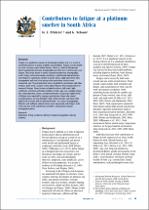JavaScript is disabled for your browser. Some features of this site may not work without it.
- ResearchSpace
- →
- Research Publications/Outputs
- →
- Journal Articles
- →
- View Item
| dc.contributor.author |
Pelders, Jodi L

|
|
| dc.contributor.author |
Nelson, G

|
|
| dc.date.accessioned | 2019-06-25T13:10:22Z | |
| dc.date.available | 2019-06-25T13:10:22Z | |
| dc.date.issued | 2019-03 | |
| dc.identifier.citation | Pelders, J.L. and Nelson, G. 2019. Contributors to fatigue at a platinum smelter in South Africa. Journal of the Southern African Institute of Mining and Metallurgy, v119(3), pp 313-319. | en_US |
| dc.identifier.issn | 2411-9717 | |
| dc.identifier.uri | http://www.scielo.org.za/scielo.php?script=sci_arttext&pid=S2225-62532019000300013 | |
| dc.identifier.uri | http://hdl.handle.net/10204/11008 | |
| dc.description | Copyright: 2019 Southern African Institute of Mining and Metallurgy | en_US |
| dc.description.abstract | Fatigue is a significant concern in the mining industry as it is a causal or contributing factor in many incidents and accidents. Fatigue can be caused by work- and non-work-related factors. There is a lack of information about associations between demographic and other non-work factors, and fatigue. This study aimed to assess associations between demographic, work, living, and socioeconomic conditions, and lifestyle characteristics, and fatigue at a platinum smelter in South Africa. Eight interviews with management and two focus groups with production workers were conducted, and 75 questionnaires were completed by production and other workers. Both work- and non-work-related factors were considered to be causes of fatigue. These factors included overtime, shift work, high workloads, activities performed outside of work, age, race, housing tenure, diet, sleep disorders, stress, and job satisfaction. In general, higher levels of fatigue were reported by younger participants, those who rented accommodation, ate less healthily, had a sleep disorder, and those with high levels of stress and low job satisfaction. As various demographic, lifestyle, and wellness-related factors were associated with fatigue, both work and non-work contributors should be addressed in fatigue management plans. | en_US |
| dc.language.iso | en | en_US |
| dc.publisher | Southern African Institute of Mining and Metallurgy | en_US |
| dc.relation.ispartofseries | Worklist;22390 | |
| dc.subject | Fatigue management | en_US |
| dc.subject | Lifestyle | en_US |
| dc.subject | Living conditions | en_US |
| dc.subject | Mining industry | en_US |
| dc.subject | Sleepiness | en_US |
| dc.title | Contributors to fatigue at a platinum smelter in South Africa | en_US |
| dc.type | Article | en_US |
| dc.identifier.apacitation | Pelders, J. L., & Nelson, G. (2019). Contributors to fatigue at a platinum smelter in South Africa. http://hdl.handle.net/10204/11008 | en_ZA |
| dc.identifier.chicagocitation | Pelders, Jodi L, and G Nelson "Contributors to fatigue at a platinum smelter in South Africa." (2019) http://hdl.handle.net/10204/11008 | en_ZA |
| dc.identifier.vancouvercitation | Pelders JL, Nelson G. Contributors to fatigue at a platinum smelter in South Africa. 2019; http://hdl.handle.net/10204/11008. | en_ZA |
| dc.identifier.ris | TY - Article AU - Pelders, Jodi L AU - Nelson, G AB - Fatigue is a significant concern in the mining industry as it is a causal or contributing factor in many incidents and accidents. Fatigue can be caused by work- and non-work-related factors. There is a lack of information about associations between demographic and other non-work factors, and fatigue. This study aimed to assess associations between demographic, work, living, and socioeconomic conditions, and lifestyle characteristics, and fatigue at a platinum smelter in South Africa. Eight interviews with management and two focus groups with production workers were conducted, and 75 questionnaires were completed by production and other workers. Both work- and non-work-related factors were considered to be causes of fatigue. These factors included overtime, shift work, high workloads, activities performed outside of work, age, race, housing tenure, diet, sleep disorders, stress, and job satisfaction. In general, higher levels of fatigue were reported by younger participants, those who rented accommodation, ate less healthily, had a sleep disorder, and those with high levels of stress and low job satisfaction. As various demographic, lifestyle, and wellness-related factors were associated with fatigue, both work and non-work contributors should be addressed in fatigue management plans. DA - 2019-03 DB - ResearchSpace DP - CSIR KW - Fatigue management KW - Lifestyle KW - Living conditions KW - Mining industry KW - Sleepiness LK - https://researchspace.csir.co.za PY - 2019 SM - 2411-9717 T1 - Contributors to fatigue at a platinum smelter in South Africa TI - Contributors to fatigue at a platinum smelter in South Africa UR - http://hdl.handle.net/10204/11008 ER - | en_ZA |






